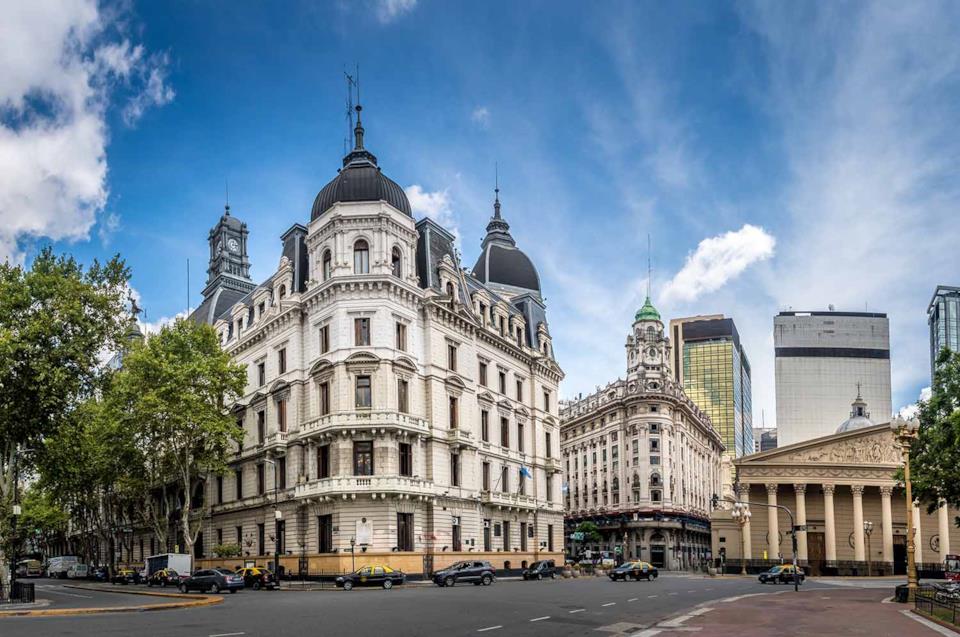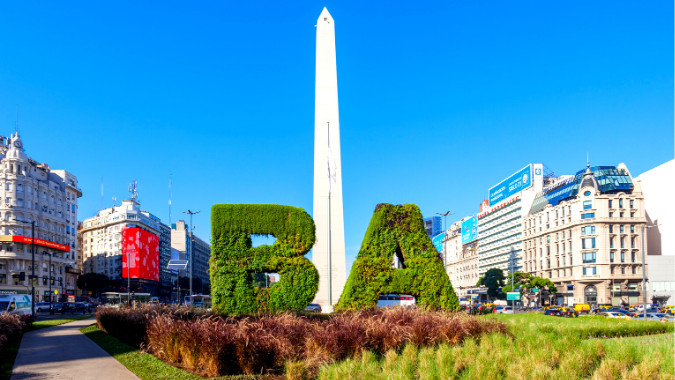by Apostol Hristov
Artwork: Apostol Hristov
Copyright © 2022
Buenos Aires

by Apostol Hristov
Artwork: Apostol Hristov
- Joined Jan 2022
- Published Books 2
Copyright © 2022
Buenos Aires (/ˌbweɪnəs ˈɛəriːz/ or /-ˈaɪrɪs/;Spanish pronunciation: [ˈbwenos ˈajɾes] (![]() listen)), officially the Autonomous City of Buenos Aires (Spanish: Ciudad Autónoma de Buenos Aires), is the capital and largest city of Argentina. The city is located on the western shore of the Río de la Plata, on South America’s southeastern coast. “Buenos Aires” can be translated as “fair winds” or “good airs”, but the former was the meaning intended by the founders in the 16th century, by the use of the original name “Real de Nuestra Señora Santa María del Buen Ayre”, named
listen)), officially the Autonomous City of Buenos Aires (Spanish: Ciudad Autónoma de Buenos Aires), is the capital and largest city of Argentina. The city is located on the western shore of the Río de la Plata, on South America’s southeastern coast. “Buenos Aires” can be translated as “fair winds” or “good airs”, but the former was the meaning intended by the founders in the 16th century, by the use of the original name “Real de Nuestra Señora Santa María del Buen Ayre”, named
Buenos Aires’ quality of life was ranked 91st in the world in 2018, being one of the best in Latin America. In 2012, it was the most visited city in South America, and the second-most visited city of Latin America.

It is known for its preserved eclectic European architecture and rich cultural life. Buenos Aires held the 1st Pan American Games in 1951 and was the site of two venues in the 1978 FIFA World Cup. Most recently, Buenos Aires hosted the 2018 Summer Youth Olympics and the 2018 G20 summit.
Buenos Aires is a multicultural city that is home to multiple ethnic and religious groups, contributing to its culture as well as to the dialect spoken in the city and in some other parts of the country.
It is recorded under the Aragonese’s archives that Catalan missionaries and Jesuits arriving in Cagliari (Sardinia) under the Crown of Aragon, after its capture from the Pisans in 1324 established their headquarters on top of a hill that overlooked the city.The hill was known to them


as Bonaira (or Bonaria in Sardinian language), as it was free of the foul smell prevalent in the old city (the castle area), which is adjacent to swampland. During the Cagliari’s siege, the Catalans built a sanctuary to the Virgin Mary on top of the hill. The statue was placed in the abbey. Spanish sailors, especially Andalusians, venerated this image and frequently invoked the “Fair Winds” to aid them in their navigation and prevent shipwrecks. A sanctuary to the Virgin of Buen Ayre would be later erected in Seville.
For many years, the name was attributed to a Sancho del Campo, who is said to have exclaimed: How fair are the winds of this land!, as he arrived. But in 1882, after conducting extensive research in Spanish archives, Argentine merchant Eduardo Madero ultimately concluded that the name was indeed closely linked with the devotion of the sailors to Our Lady of Buen Ayre.

The usual abbreviation for Buenos Aires in Spanish is Bs.As. It is common as well to refer to it as “B.A.” or “BA”. When referring specifically to the autonomous city, it is very common to colloquially call it “Capital” in Spanish. Since the autonomy obtained in 1994, it has been called “CABA” (per Ciudad Autónoma de Buenos Aires, Autonomous City of Buenos Aires).
While “BA” is used more by ex-pats residing in the city, the locals more often use the single word abbreviation “Baires.”
The city of Buenos Aires lies in the pampa region, with the exception of some areas such as the Buenos Aires Ecological Reserve, the Boca Juniors (football club)’s “sports city”, Jorge Newbery Airport, the Puerto Madero neighborhood and the main port itself; these were all built on reclaimed land along the coasts of the Rio de la Plata (the world’s widest river).
The region was formerly crossed by different streams and lagoons, some of which were refilled and others tubed. Among the most important streams are the Maldonado, Vega, Medrano, Cildañez, and White. In 1908, as floods were damaging the city’s infrastructure, many streams were channeled and rectified; furthermore, starting in 1919, most streams were enclosed. Most notably, the Maldonado was tubed in 1954; it currently runs below Juan B. Justo Avenue.


Buenos Aires has a thriving arts culture, with “a huge inventory of museums, ranging from obscure to world-class.” The barrios of Palermo and Recoleta are the city’s traditional bastions in the diffusion of art, although in recent years there has been a tendency of appearance of exhibition venues in other districts such as Puerto Madero or La Boca; renowned venues include MALBA, the National Museum of Fine Arts, Fundación Proa, Faena Arts Center, and the Usina del Arte. Other popular institutions are the Buenos Aires Museum of Modern Art, the Quinquela Martín Museum, the Evita Museum, the Fernández Blanco Museum, the José Hernández Museum, and the Palais de Glace, among others. A traditional event that occurs once a year is La Noche de los Museos (“Night of the Museums”), when the city’s museums, universities, and artistic spaces open their doors for free until early morning; it usually takes place in November.

According to the Harvard Dictionary of Music, “Argentina has one of the richest art music traditions and perhaps the most active contemporary musical life” in South America. Buenos Aires boasts of several professional orchestras, including the Argentine National Symphony Orchestra, the Ensamble Musical de Buenos Aires and the Camerata Bariloche; as well as various conservatories that offer professional music education, like the Conservatorio Nacional Superior de Música.
Italian music was very influential during the 19th century and the early 20th century, in part because of immigration, but operas and salon music were also composed by Argentines, including Francisco Hargreaves and Juan Gutiérrez. A nationalist trend that drew from Argentine traditions, literature and folk music was an important force during the 19th century, including composers Alberto Williams, Julián Aguirre, Arturo Berutti and Felipe Boero. In the 1930s, composers such as Juan Carlos Paz and Alberto Ginastera “began to espouse a cosmopolitan and modernist style, influenced by twelve-tone techniques and serialism”; while avant-garde music thrived by the 1960s, with the Rockefeller Foundation financing the Centro Interamericano de Altos Estudios Musicales, which brought internationally famous composers to work and teach in Buenos Aires, also establishing an electronic music studio.

ccording to the World Travel & Tourism Council, tourism has been growing in the Argentine capital since 2002. In a survey by the travel and tourism publication Travel + Leisure Magazine in 2008, visitors voted Buenos Aires the second most desirable city to visit after Florence, Italy. In 2008, an estimated 2.5 million visitors visited the city.
Visitors have many options for travel such as going to a tango show, an estancia in the Province of Buenos Aires, or enjoying the traditional asado. New tourist circuits have recently evolved, devoted to Argentines such as Carlos Gardel, Eva Perón or Jorge Luis Borges. Before 2011, due to the Argentine peso’s favorable exchange rate, its shopping centers such as Alto Palermo, Paseo Alcorta, Patio Bullrich, Abasto de Buenos Aires and Galerías Pacífico were frequently visited by tourists. Nowadays, the exchange rate has hampered tourism and shopping in particular. In fact, notable consumer brands such as Burberry and Louis Vuitton have abandoned the country due to the exchange rate and import restrictions. The city also plays host to musical festivals, some of the largest of which are Quilmes Rock, Creamfields BA, Ultra Music Festival (Buenos Aires), and the Buenos Aires Jazz Festival.


Published: Jan 25, 2022
Latest Revision: Jan 25, 2022
Ourboox Unique Identifier: OB-1269954
Copyright © 2022







